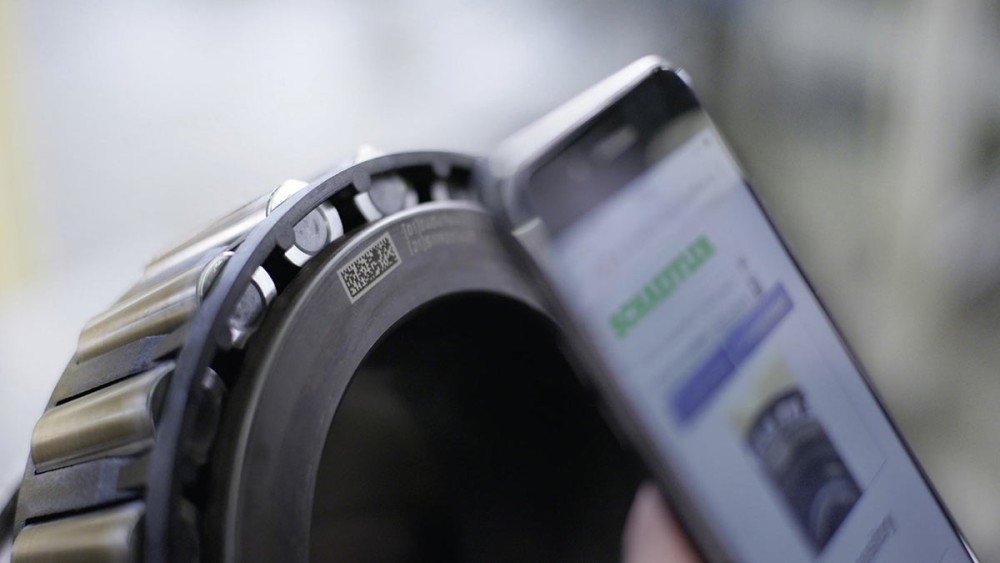Schaeffler at InnoTrans, Hall 21, Booth 430 Smart and flexible: Condition-based monitoring using data from sensors

2022-09-20 | Schweinfurt/Berlin
- Linking databases using the Data Matrix Code is enabling sustainable, condition-based maintenance concepts
- Schaeffler adds bearing condition diagnosis to existing vehicle-based condition monitoring systems
- Railway Condition Monitoring System (RCMS) for digitalized monitoring and maintenance of complete motor and/or trailer bogies in passenger trains
Digitalization in rail transport also offers huge benefits for maintenance planning. The basis for this is sensor data from fixed measuring stations or onboard systems installed in rail vehicles. At InnoTrans 2022, Schaeffler, a leading global supplier to the automotive and industrial sectors, will show the various ways in which customers can exploit this data. This is how the company ensures the best possible safety and availability of rail vehicles.
Extended service life and greater system expertise thanks to digital data transfer
The application of the DMC to bearing components is the basis for the development of a digital supply chain comprising component manufacturer, OEM and rail operator by means of standardized data exchange. The DMC provides components with a unique digital laser marking. Manufacturing, assembly, and maintenance data are stored in the linked database. This generates a digital twin, which at the same time allows the installed bearings to be clearly assigned to the respective rail vehicles.
But it doesn’t stop there. The digital twin realizes its full potential when, in addition to the data from the component manufacturer, data from the OEM and rail vehicle operator are captured as well. The digital twin of a bearing contains information about the axlebox, bogie, and rail car that the bearing was installed in at the OEM. Following delivery, real-time data from train operation can then be added continually. These include bearing mileage or sensor-based temperature or vibration measurements.
Evaluation of data from third party onboard condition monitoring systems
Using existing onboard condition monitoring systems for diagnosing axlebox bearings is an approach that Schaeffler is currently pursuing through a collaboration with ZF. In rail vehicles equipped with the ZF connect@rail system, Schaeffler uses the existing sensors and onboard unit gateways of ZF. The vibration data collected are transmitted wirelessly to a cloud, where they are evaluated automatically by analysis software specifically designed for the maintenance of bearings and then used for the proactive planning of bearing maintenance and upkeep.
In this case, the rail operator benefits from the fact that there is no need to install a separate onboard system. Thanks to wireless sensors, the condition monitoring solution can simply be retrofitted to existing fleets. The modular design of ZF’s connect@rail platform also allows additional sensors, analysis methods and consequently, monitoring functions, to be added to the system depending on customer requirements.
The solution developed with ZF that will be showcased at InnoTrans is a good example of the technical feasibility of readily combining the system with the condition monitoring systems of other vendors.
Proactive maintenance: Schaeffler Railway Condition Monitoring System (RCMS)
Schaeffler has developed its own complete, wired system for the predictive condition monitoring of complete motor and/or trailer bogies in passenger trains. Sensors integrated into the rail vehicle measure acceleration, speed, and temperature. The data are stored in an onboard server, so it is not absolutely necessary to transfer them via cloud. The data are also analyzed and processed directly in the vehicle using process modules and specialized software. The analysis of vibration signals provides very early indications of unusual mechanical loads. Operators and maintenance personnel can monitor the condition of individual axlebox bearings or complete axleboxes and bogies from anywhere in the world via a secure internet connection and schedule maintenance before even the slightest functional impairment has occurred.
Schaeffler’s wired RCMS is especially relevant for manufacturers of trains designed for higher speeds. Particularly for the transfer of temperature data, these trains must satisfy strict requirements relating to the reliable transmission of signals.
At InnoTrans, Schaeffler will also illustrate the benefits of its RCMS system for operation and maintenance based on the monitoring of axlebox bearings, starting with the important aspect of operational reliability: The early detection and fast web-based transmission of deviations from set values reduce the risk of unscheduled downtimes. Being able to plan maintenance and upkeep using condition monitoring above all provides economic advantages, as it replaces reactive maintenance and avoids unnecessary preventive maintenance. Ultimately, this results in longer maintenance intervals and higher bearing mileage, which are associated with significant cost and time savings.
Publisher: Schaeffler AG
Country: Germany
Terms of use for Schaeffler press pictures
Schaeffler press pictures may only be used for editorial purposes. Unless otherwise stated, all copyrights and rights of use and exploitation are owned by Schaeffler Technologies AG & Co. KG, Herzogenaurach (Germany) or by one of its affiliated companies. The reproduction and publication of Schaeffler press pictures is only permitted if the source is stated as follows: "Image: Schaeffler". The pictures may be used free of charge in such cases. The use of pictures for advertising or other commercial purposes, in particular their disclosure to third parties for commercial purposes, is hereby prohibited. Pictures may only be edited with the approval of Schaeffler.
We kindly request that a specimen copy be sent to us when Schaeffler press pictures are published in printed media (or a digital copy in the case of publication in electronic media). When using Schaeffler press pictures in films, please notify us and state the title of the film.
Use and utilization of Schaeffler press pictures is subject to the substantive laws of Germany without its conflict of law provisions. The place of competent jurisdiction shall be Nuremberg, Germany.
Postal address:
Schaeffler Technologies AG & Co. KG
Corporate Communication
Industriestrasse 1-3
91074 Herzogenaurach
Germany
Press releases
Package (Press release + media)



